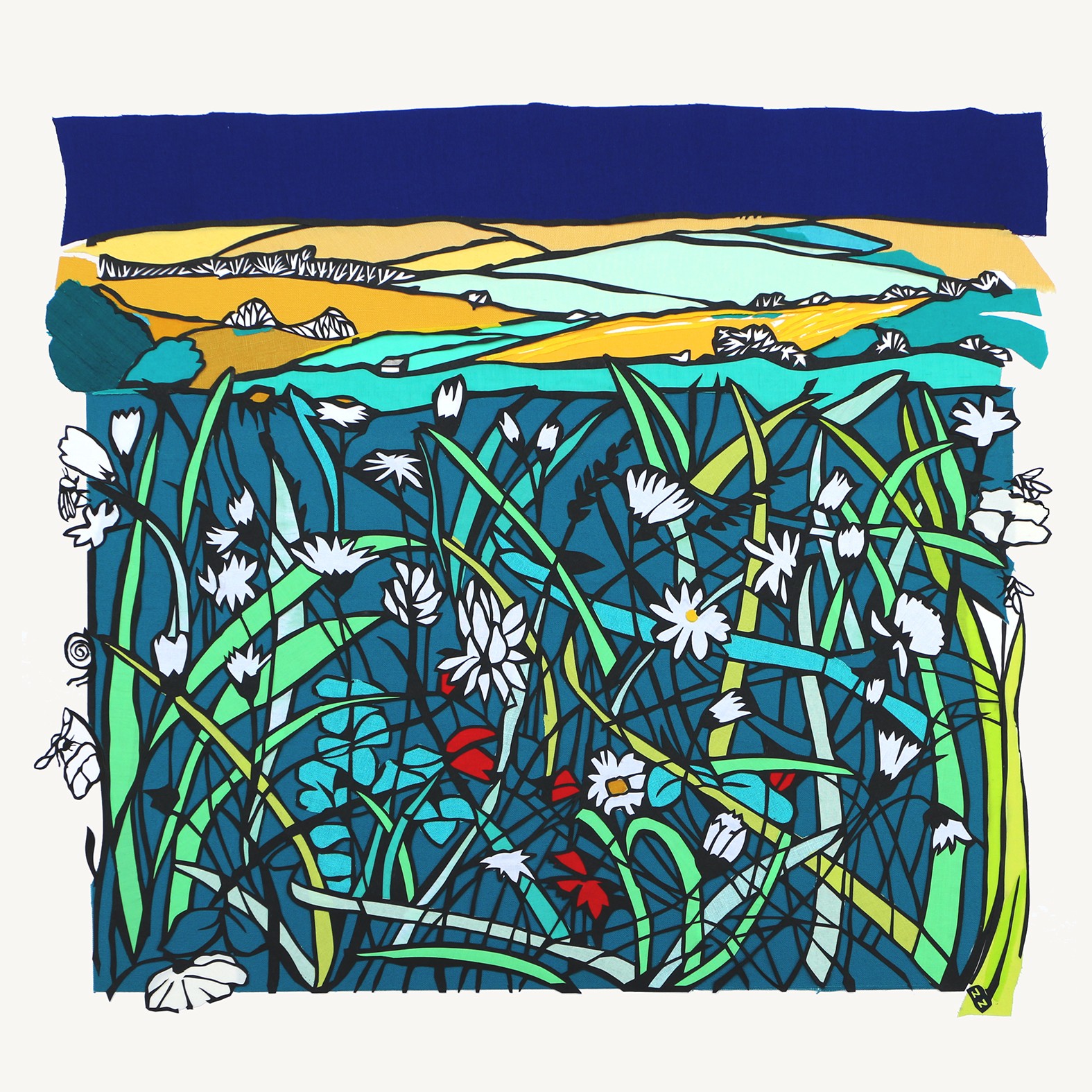Longcliffe Award
The £200 Longcliffe award is awarded for a work that references the environment. The sponsor of this prize is Longcliffe Community Fund, set up by local company Longcliffe Quarries Limited. Longcliffe is striving to increase the sustainability of its business, including aiming to be carbon neutral by 2030. The company has turned many of its former operational sites into nature reserves and is committed to minimising the impact of its operations on the environment.
All exhibiting artists are eligible.
Ali Jeffries
I create pieces by manipulating and cutting, or sometimes tearing paper and then layering it in depth.
I use sumptuous textures and colours to create art which is not only visual but also tactile – using other senses and reflective properties to pull you in and let you escape for a little while.
The piece shows how nature in its majesty can transform landscapes. Not only from a point of sustainability, but also visually, so that in contrast even the grey and stark takes on a beauty of its own.
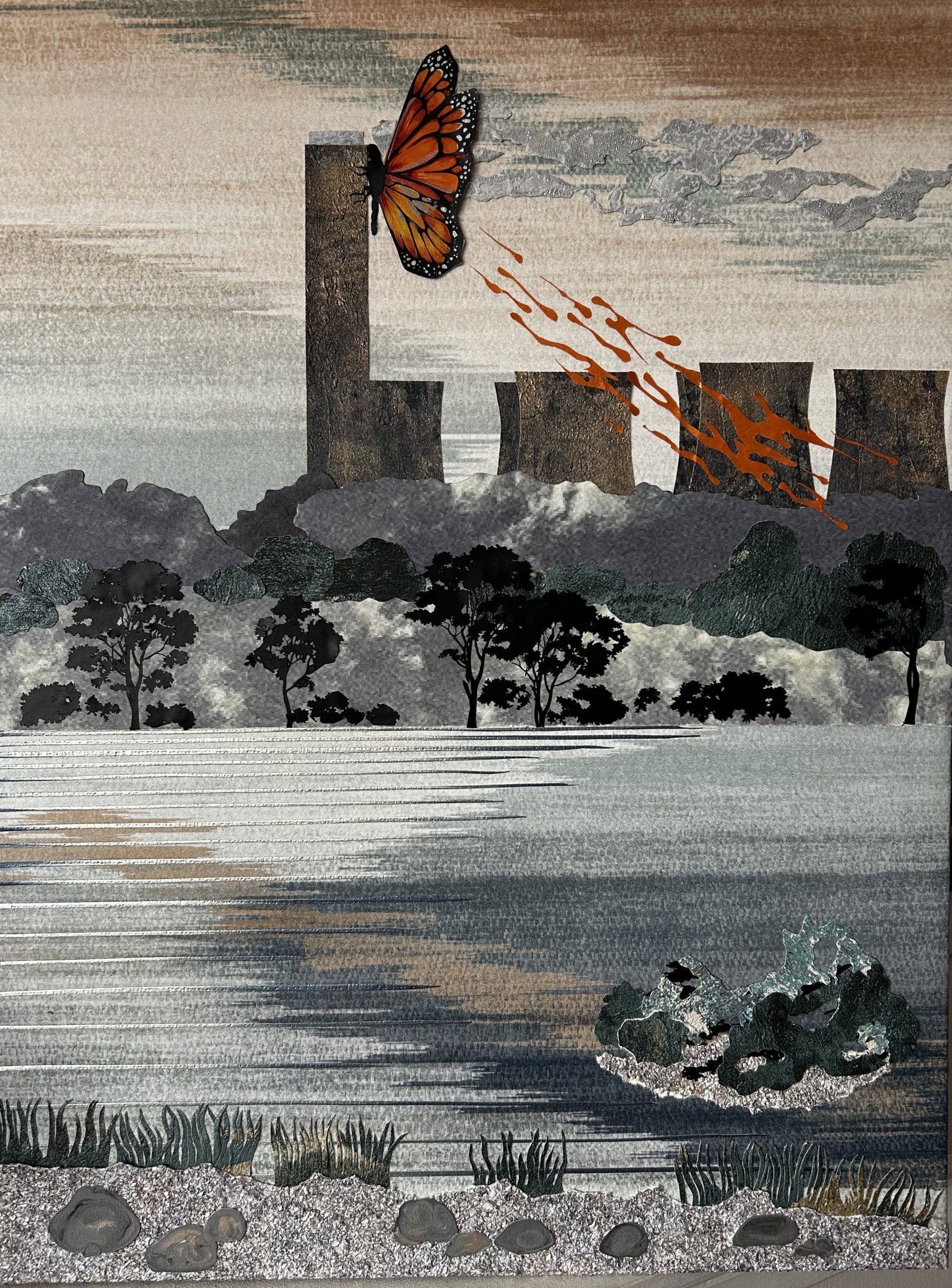
Ally Kendrick Clew
AQUEDUCT STEPS, BULLBRIDGE
This sculpture, Aqueduct Steps, Bullbridge celebrates the transition of the listed monument from a site of heavy industry on the Cromford Canal into a successful wildlife haven which provides habitat for a number of rare species.
Thanks to the owner and local residents, the aqueduct retains its important history as part of the Lime Wharf whilst becoming a wildlife corridor and recreation area for the village.
The sculpture is made from reclaimed copper, wood from a nearby fallen tree and slates from the cottage by the aqueduct which was formally stabling for the canal horses.
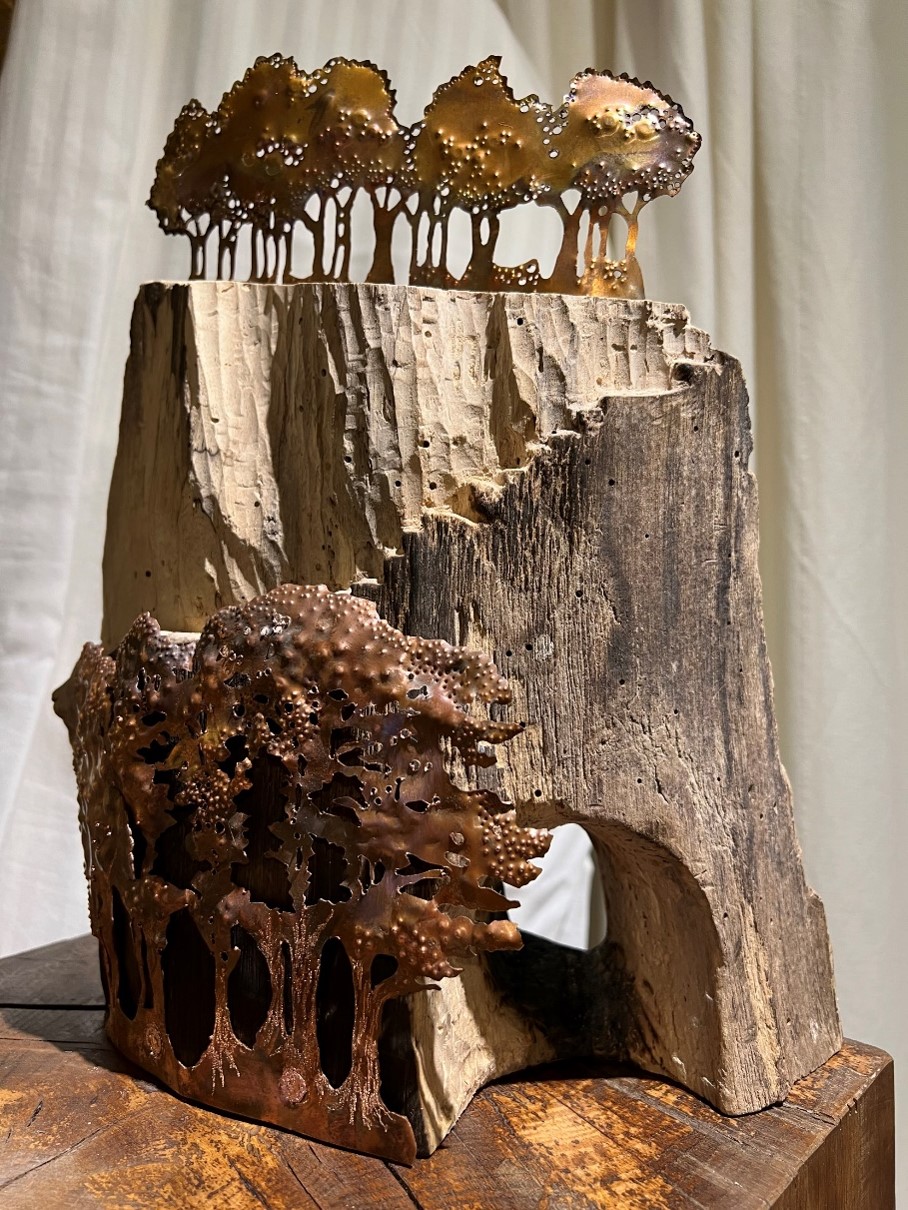
Amanda Hughes
A NEW MORNING
I have always loved colour and time with nature, being in the fresh air in the countryside makes me feel alive and renewed, I love colour, music and dance. I enjoy seeing birds flying together like dancers in the sky, listening to their birdsong and observing the changes in the landscape. My creative work celebrates what I love and my vibrant and joyful palette represents the gratitude and happiness I feel when I am immersed in the process of painting.
The skylarks have returned and are singing up on high. With winter barley one side of my home studio and rapeseed already tall and growing in the other field it all bodes well for multiple nesting cycles before the harvest is taken. The Skylarks benefit from the return of Rapeseed and Winter Barley to nest in for their next nest. (Our hive of bees may not due to the legalising of bee harming pesticides probably used on Rapeseed.)
Skylarks are a theme in my art in 2024, they symbolise everything I love about life in the Countryside. It is paradise, a constantly changing landscape. I paint what I love with colours and sparkling lines which mirror these feelings and imaginings.
In this painting the dawn stirrings of a cluster of skylarks are imagined amongst the tall crop. They have woken to a bright new morning and are ready to soon sore high and sing their unique high pitched tremolo notes.
Due to high numbers lost to predation Skylarks have four nests a year. My studio is amongst their fields on a hill-top we live off grid amongst so many animals and birds. This painting is in their honour and a celebration of my mid-life moments here on the outskirts of historic Melbourne.
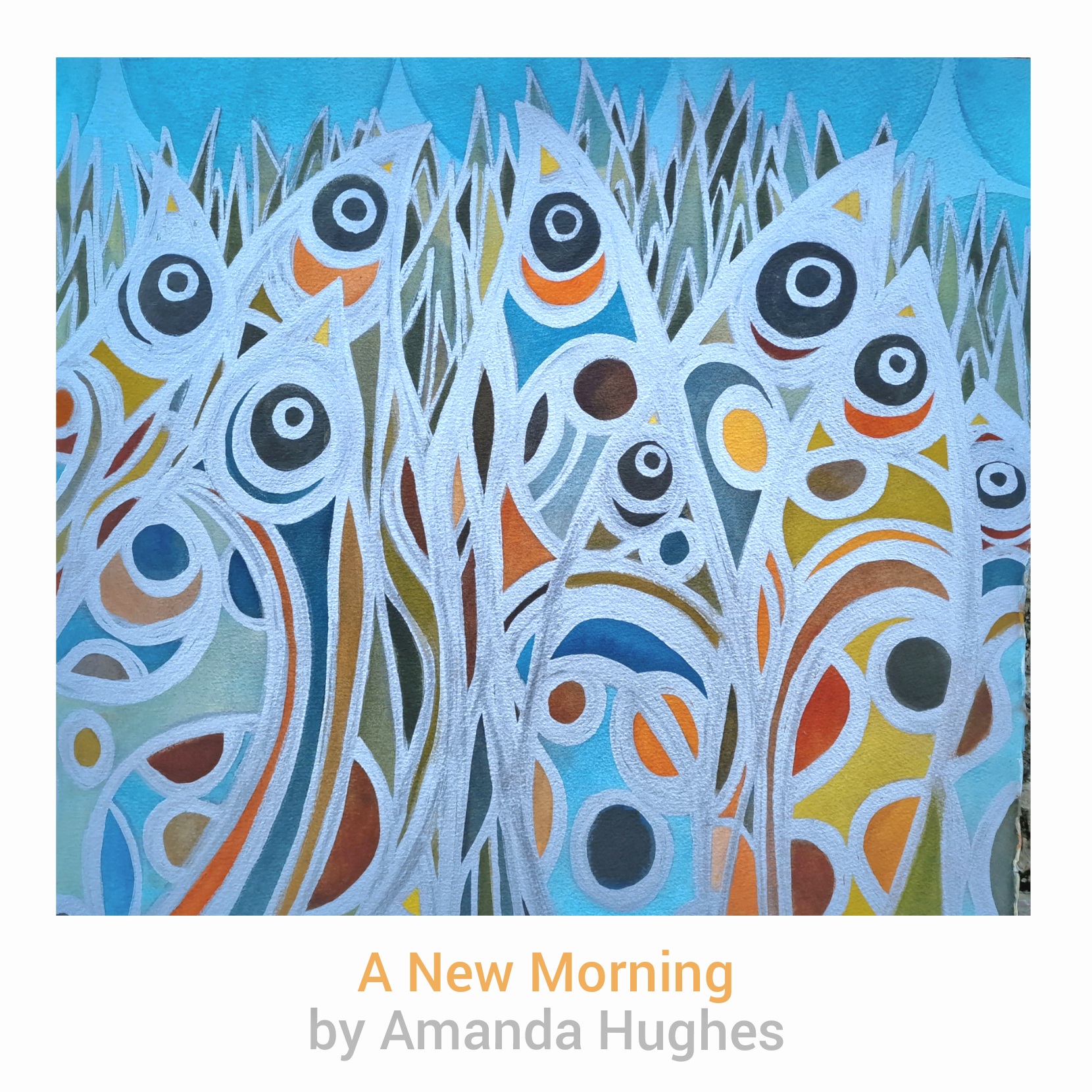
Belysning
MOUTH OFF FOR CLIMATE CHANGE!!!
A surrealist depiction of action of Longcliffe employees working towards environmental sustainability.
Recycled paper, framed using rolled comic book pages and cardboard from thrown away industrial waste.
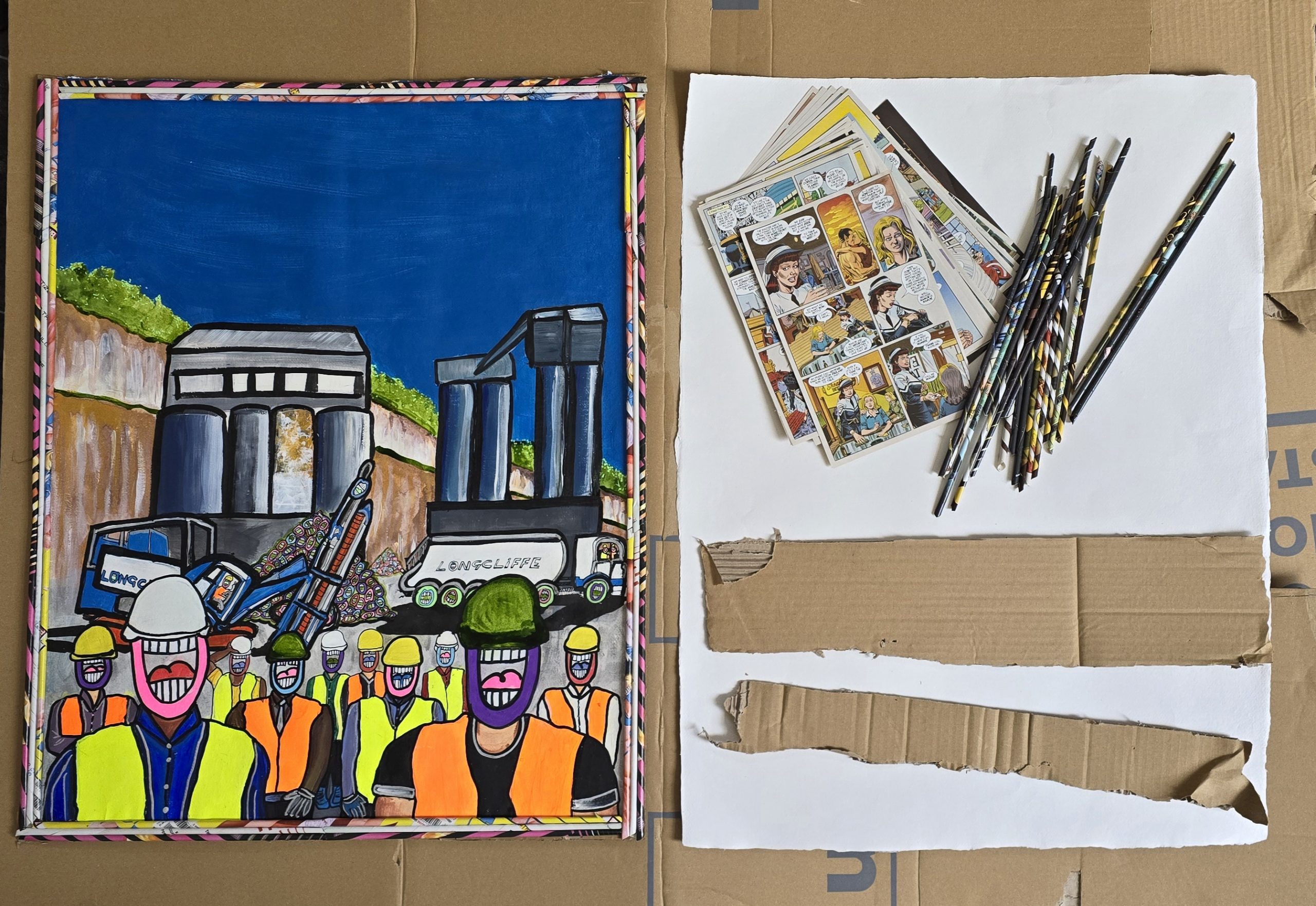
Charis Jones
The boxing hares are made from steel, which is an incredibly sustainable material. It is long lasting-hundreds of years- and over 90% of steel used in Britain is recycled.
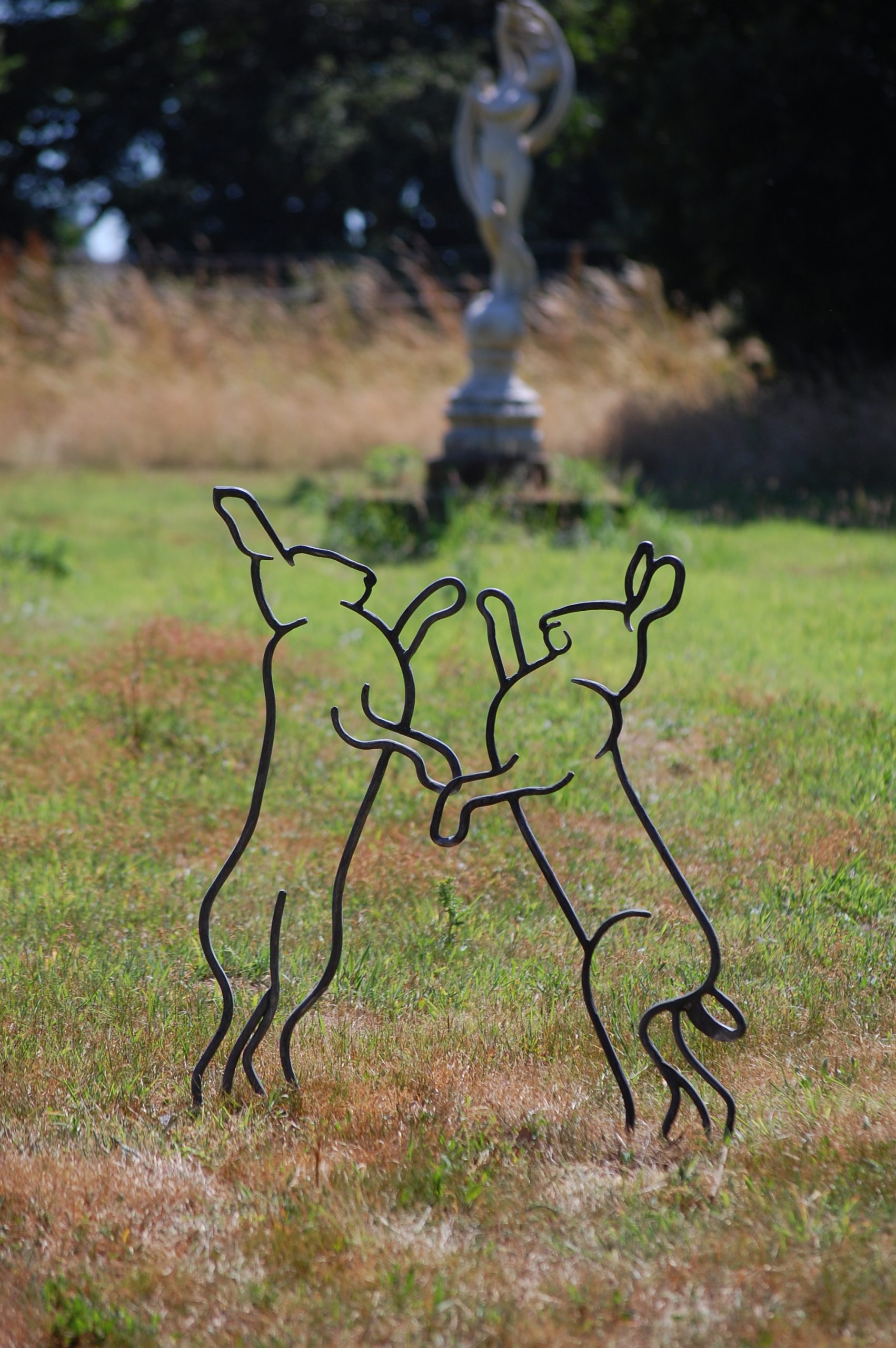
Chris Tkacz
FROM AMMONITE TO WIND
Egg tempera on board.
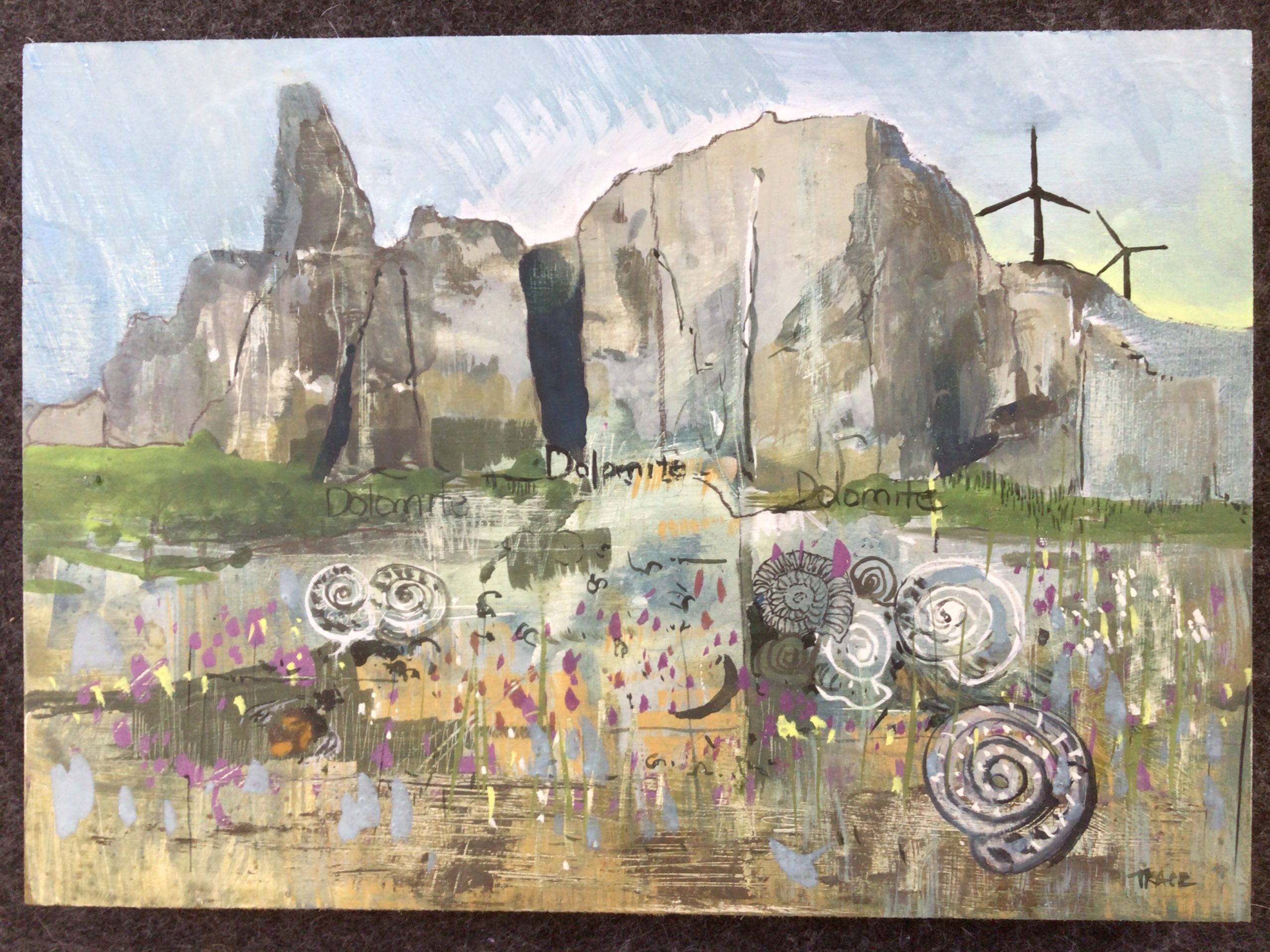
Diana Green
HANGING ON
Painted using handmade watercolours, made using local natural pigments gathered from limestone, ochres, charcoal, sandstones and clays mixed with gathered cherry tree resin binder. Using natural acorn and alder cone inks for the background. Painted on a canvas bought from a charity shop, re primed using eco (plastic free) gesso.
This tree stands at the edge of Hoe Grange just off of the road to Longcliffe Quarry. It’s roots reaching out to support itself despite the steep slope and eroded soil. A testament to strength in the face of adversity.
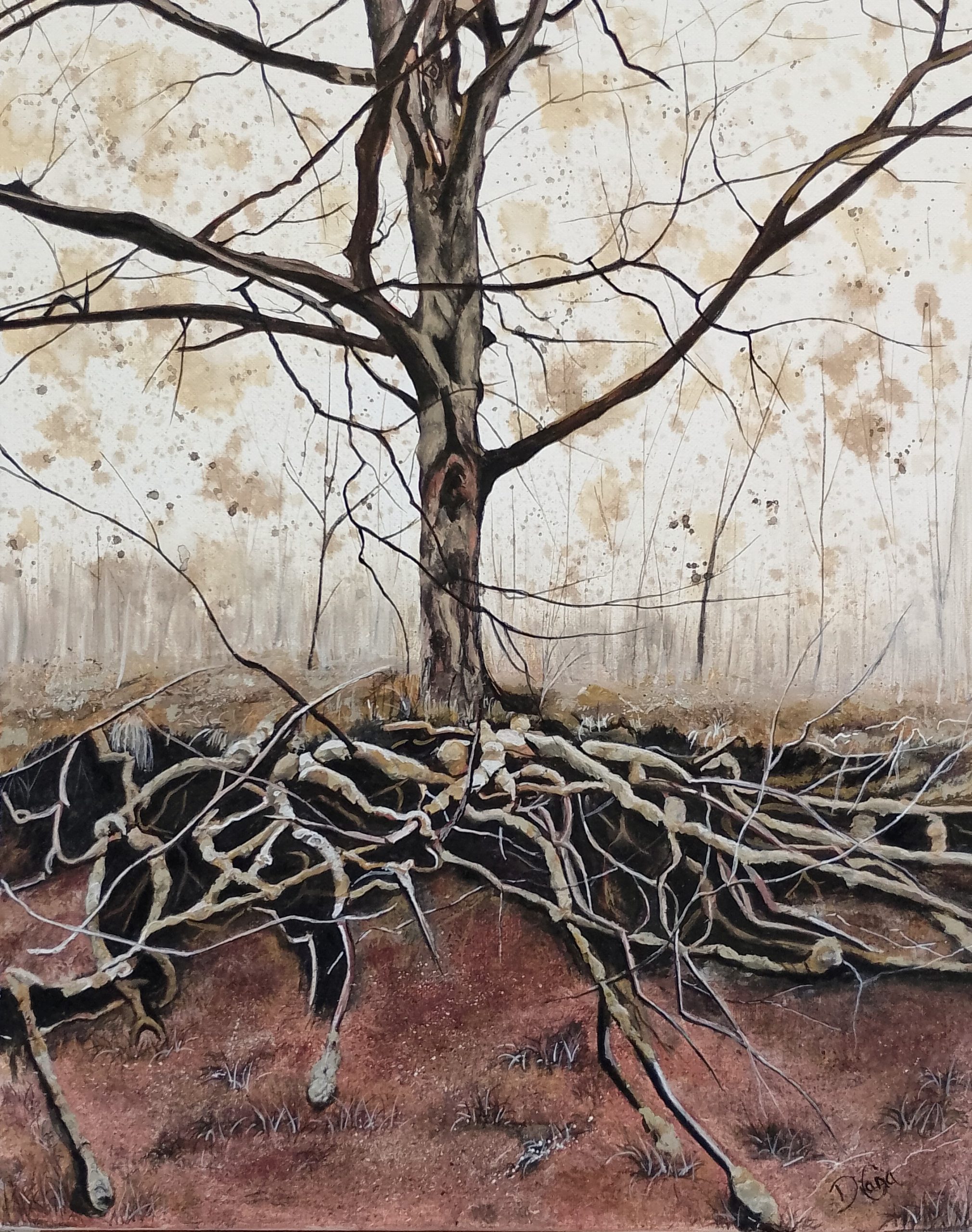
Ed Noot
DAISY MEADOW
Oxeye Daisies have an incredible ability to profligate even under the most challenging conditions. They provide a habitat and are exploited by various pollinating insects, including butterflies, bees, beetles and hoverflies.
I’ve tried to capture their strength and also their delicate nature.
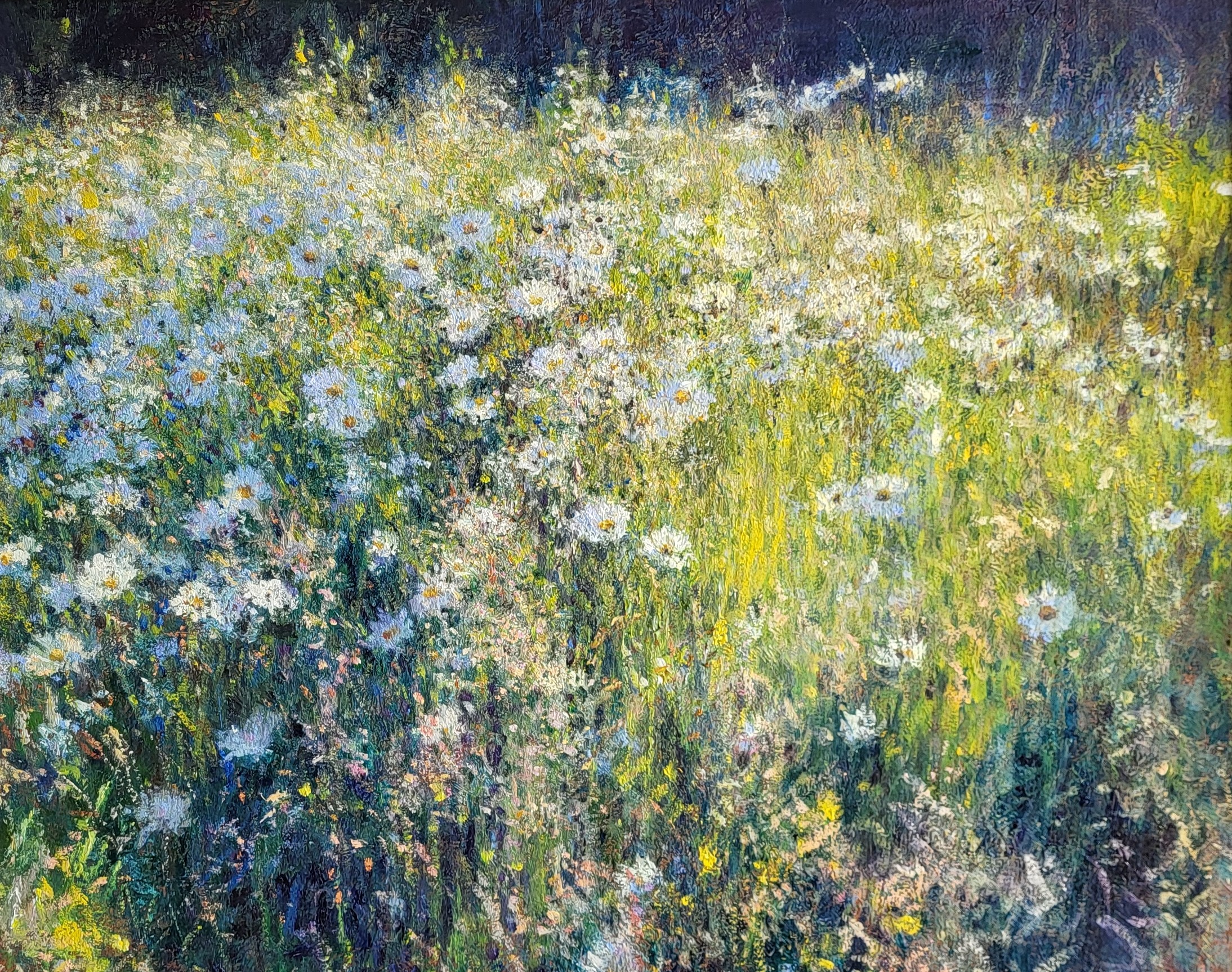
Isobel Maltby
REGENERATION. POPPIES AND WHITE FLOWERS
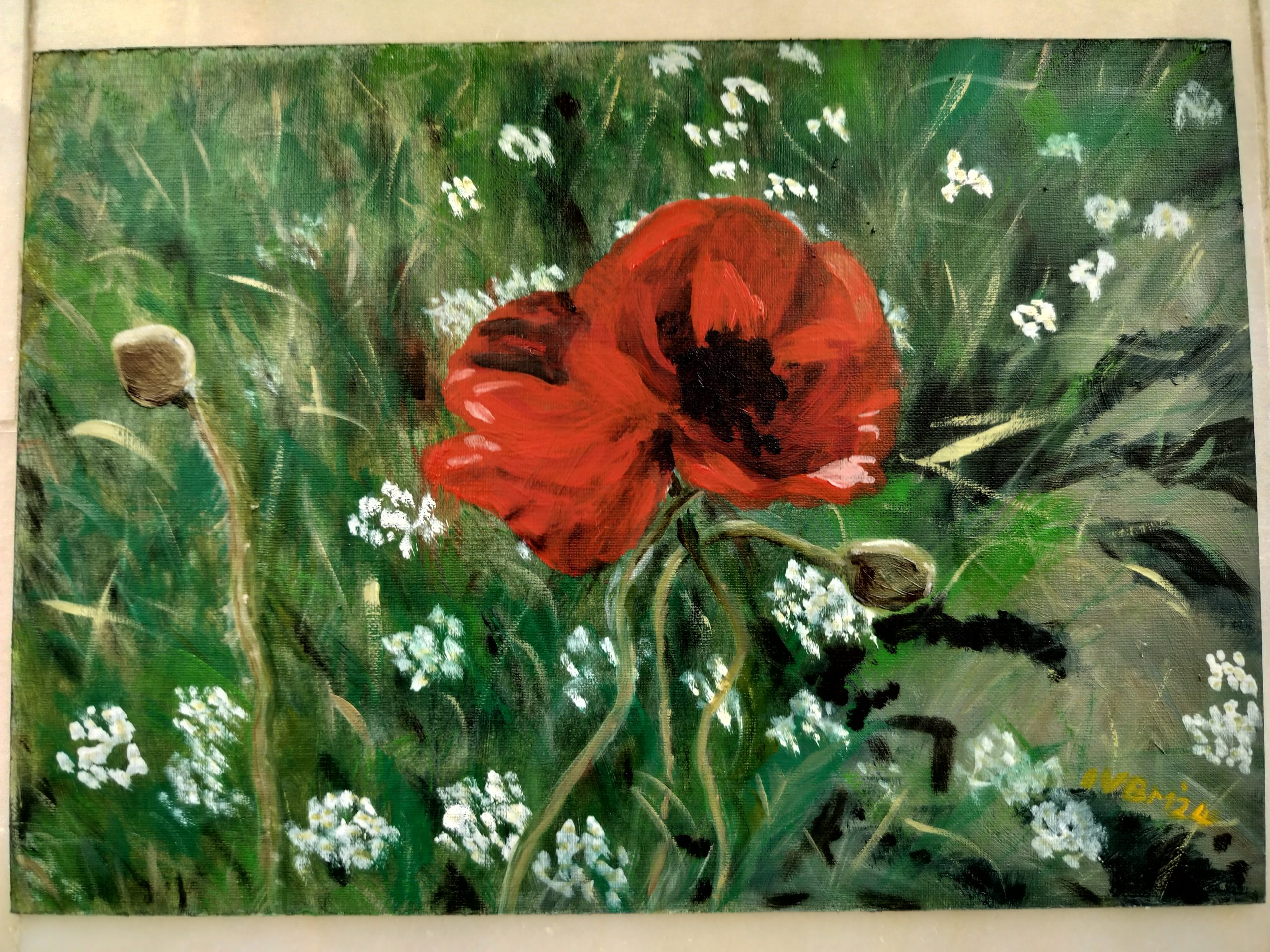
Jackie Ward
HEDGEROWS FOR BUNNIES
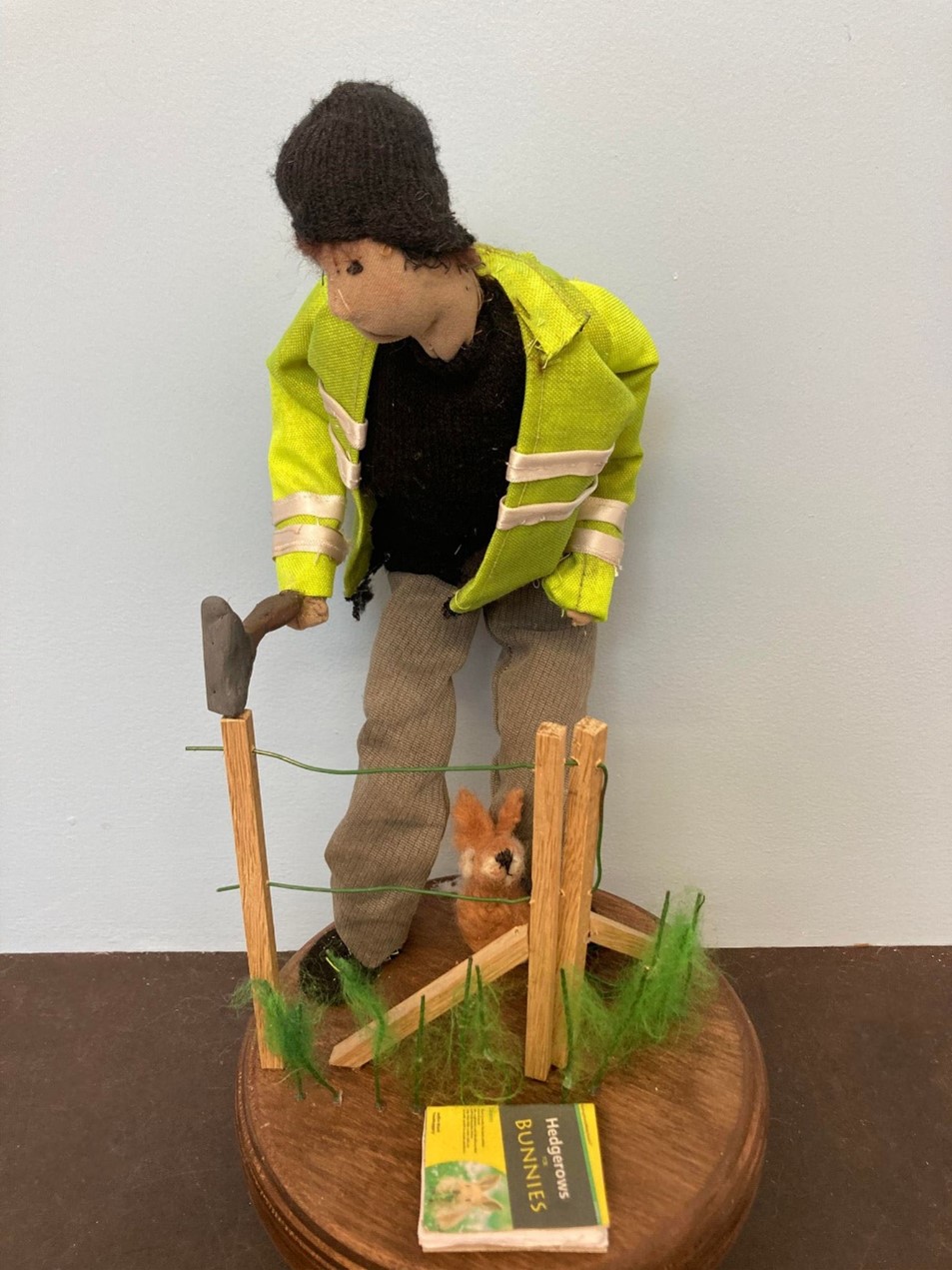
Jenny Tozer
RECLAMATION – MIXED MEDIA
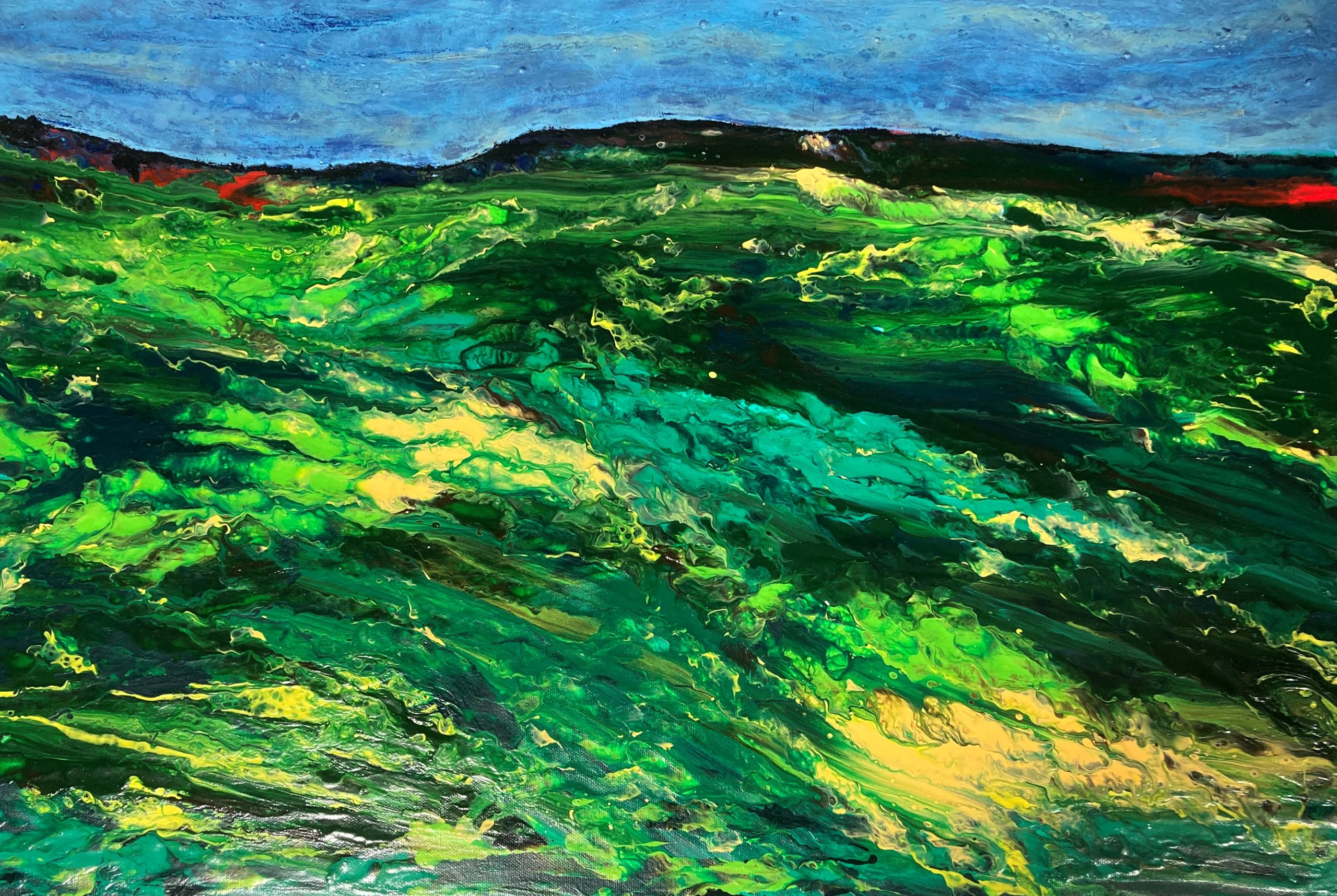
Julia Preston
OLD BORROWDALE QUARRY
I painted this from a photo I took whilst on an orienteering training day in Borrowdale. I already enjoy the challenge of painting textural stone walls and rocks in acrylics so this was ideal subject matter.
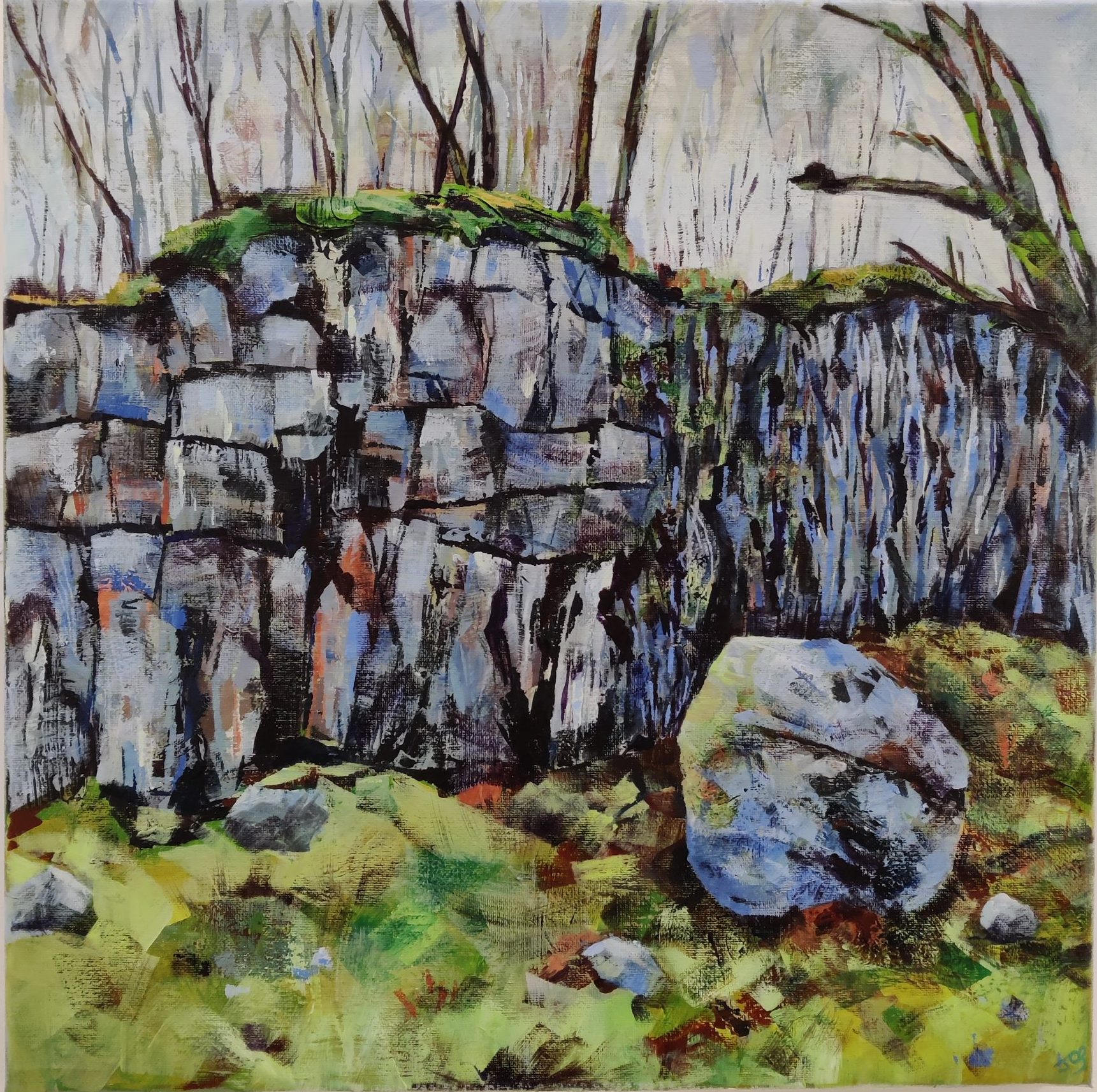
Julia Vaughan
ROCKS IN THE UNDERGROWTH

Julie Leggett
WORKING TOGETHER
Despite the industrial backdrop of the quarry, the bird thrives, echoing harmony between nature and industry. The bird is the focal point, representing freedom, transformation and connection uniting contemplation and exploring boundaries.
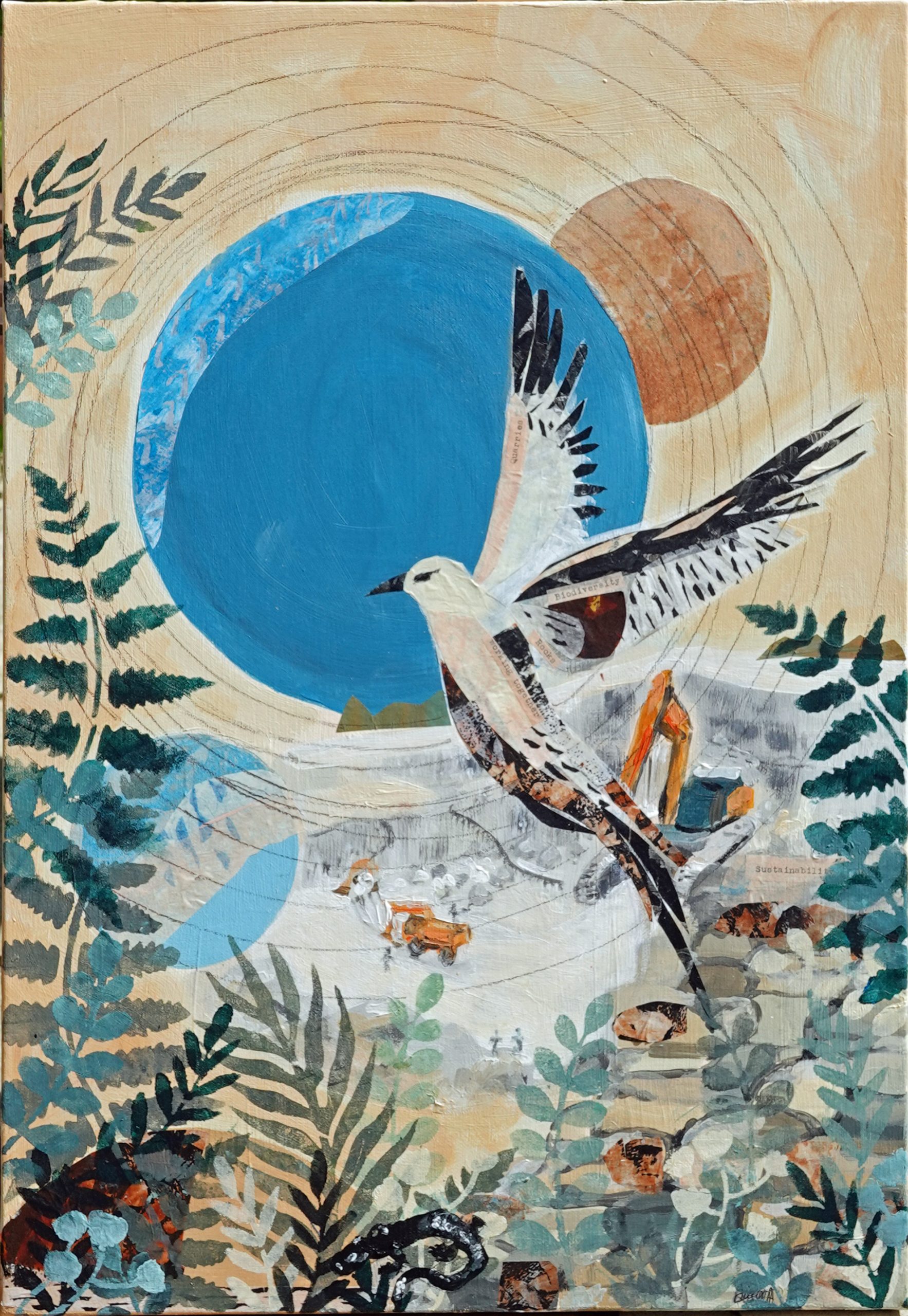
Karen Wicks
FAIRY BARN IN BONSALL
A collagraph print made using recycled packaging from one of the Bonsall Barns that I am currently studying to illustrate their sustainability as a feature of the local landscape.
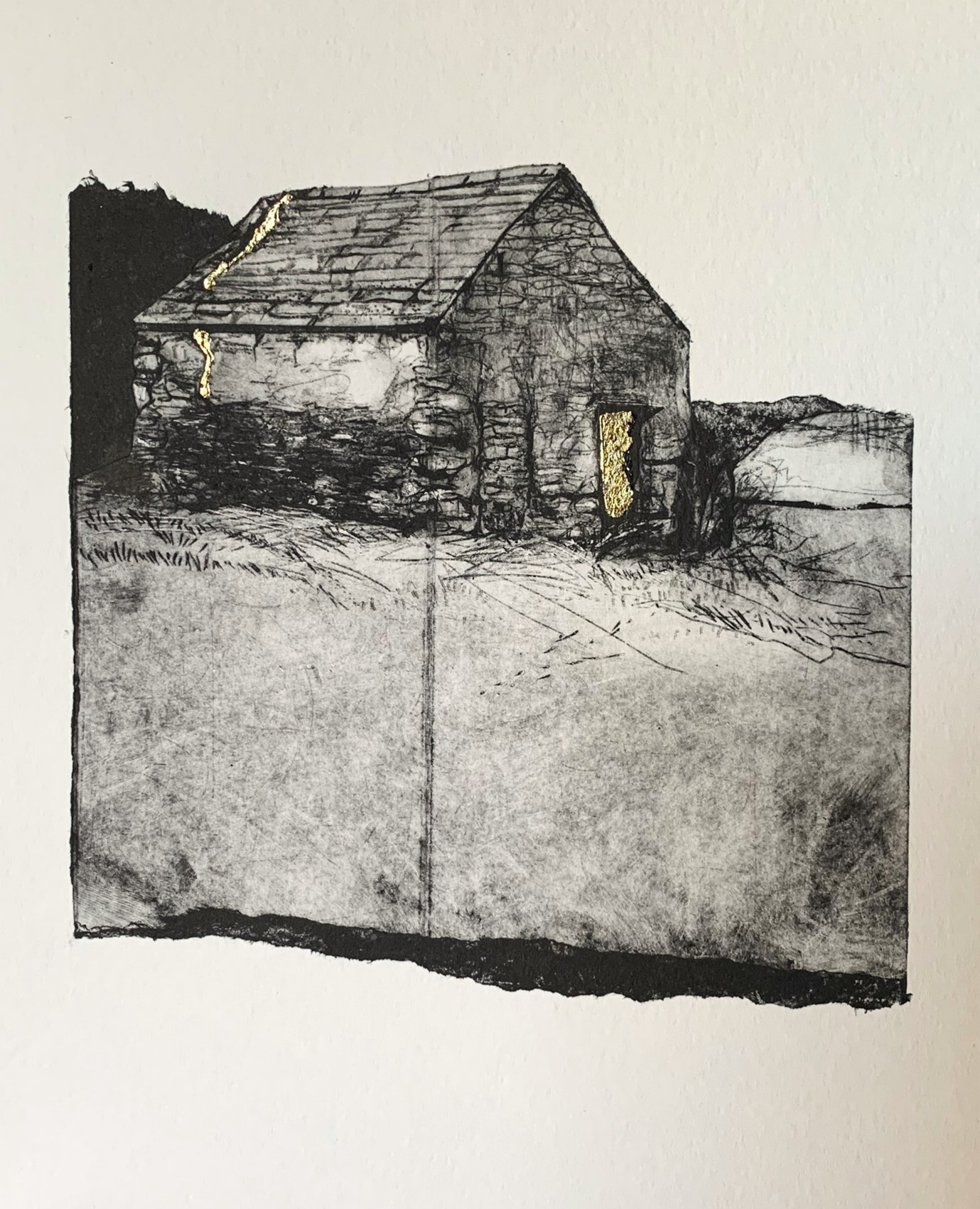
Ray Gumbley
TRANSMUTATION
Transmutation is a 3D conceptual sculpture composed of limestone, glass, dried wildflowers, and grass. This piece encapsulates the profound transformation of materials and landscapes.
One of the things limestone is used for is to make glass. Limestone, quarried from the earth, is represented in this piece as a glass vessel for carrying water and a glass rolling pin for flour and bread, which in turn symbolise sustenance and nourishment.
The glass rolling pin, now filled with limestone and wildflowers serve as a time capsule, and the limestone decorated water jug stand for once-excavated land now returned to nature, which blooms with wildflowers and wildlife, signifying renewal and well-being for all living species that encounter it.
The two vessels are placed on glass mirrors to represent reflection and the search for a better future. Through this sculpture, I hope to poetically illustrate simply the cycle of change—from extraction to creation to rejuvenation.

Richard Allen
SUSTAINING THE ENVIRONMENT IN THE DERBYSHIRE DALES
Watercolour painting of Hoe Grange quarry and the local environment of the Derbyshire Dales. It illustrates how sustainable activities have impacted on the landscape and nature.
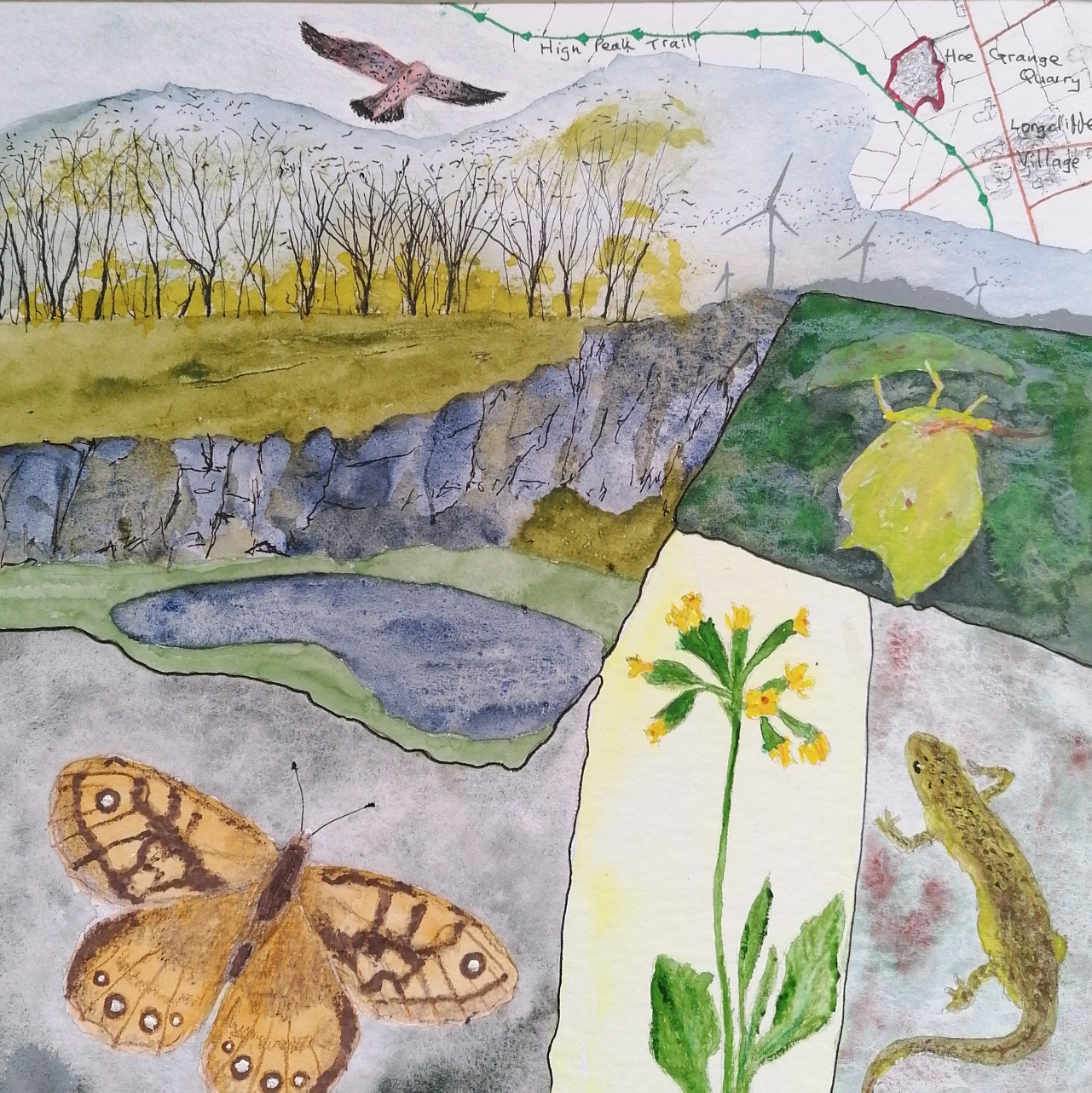
Richard Bett
THE GETTERS
The Getters is inspired by ‘Delving along the Derwent – a history of 200 quarries and the people who worked in them’. This invaluable book encourages us to understand and care for the quarrying legacy of the Lower Drwent Valley. The late Ian Thomas co-ordinated the Delvers Team to research this book. Ian, best known as the founder and director of The National Stone Centre, was also an accomplished artist.
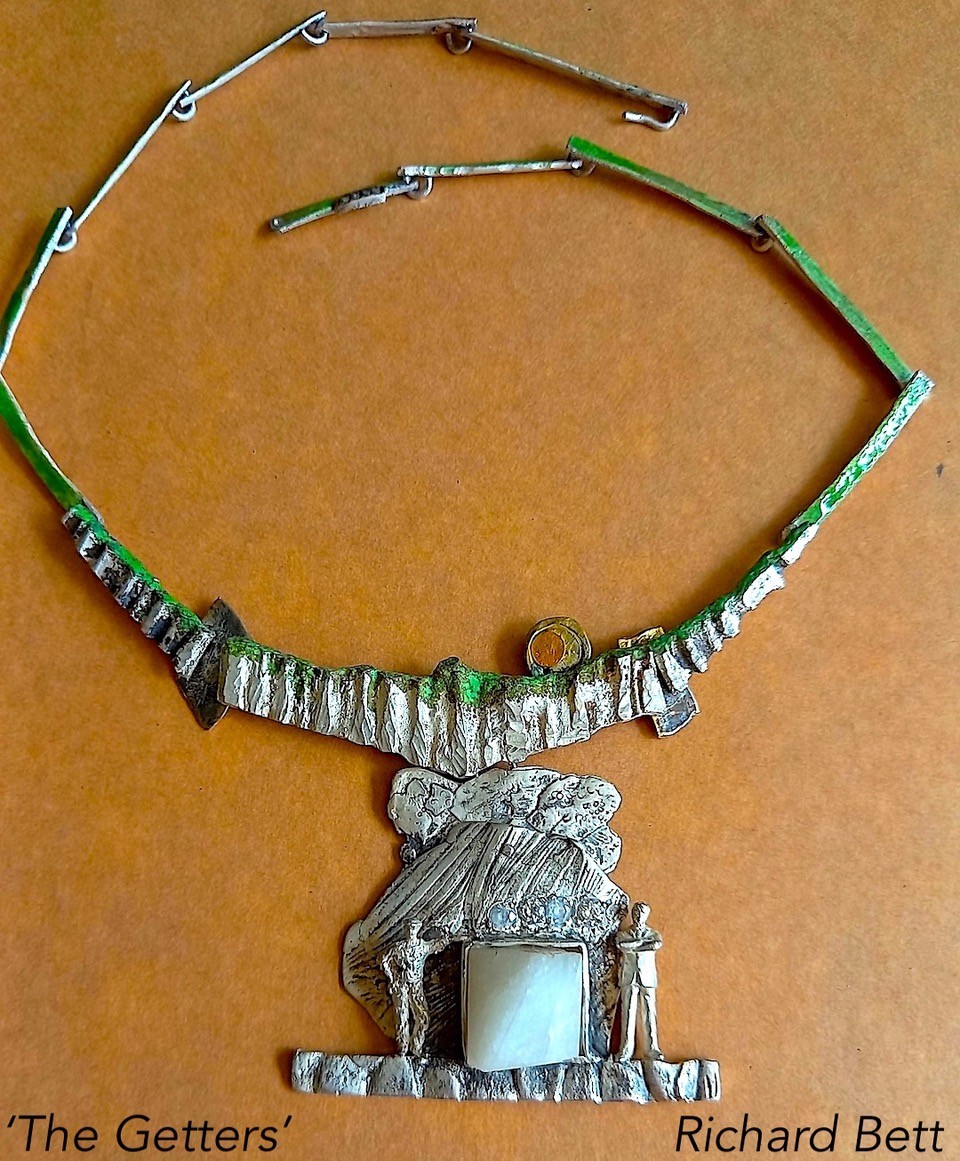
Sian Hallam
RAVENS AT HOE GRANGE QUARRY
This large painting (32″ x 40″) was inspired by a visit to Hoe Grange Quarry, which is a disused quarry that has been turned into a nature reserve by Longcliffe.
I met with Ray Walker aka “Badger”, who showed me around. I was delighted to see ravens nesting there, and the dew pond that Longcliffe have created was full of toad tadpoles and smooth newts. It is truly lovely that this rugged disused quarry face has provided our largest corvid, the raven, with a suitable breeding site and this is surely an emblem of hope, and evidence of the positive impact nature reserves such as Hoe Grange Quarry have on nature.
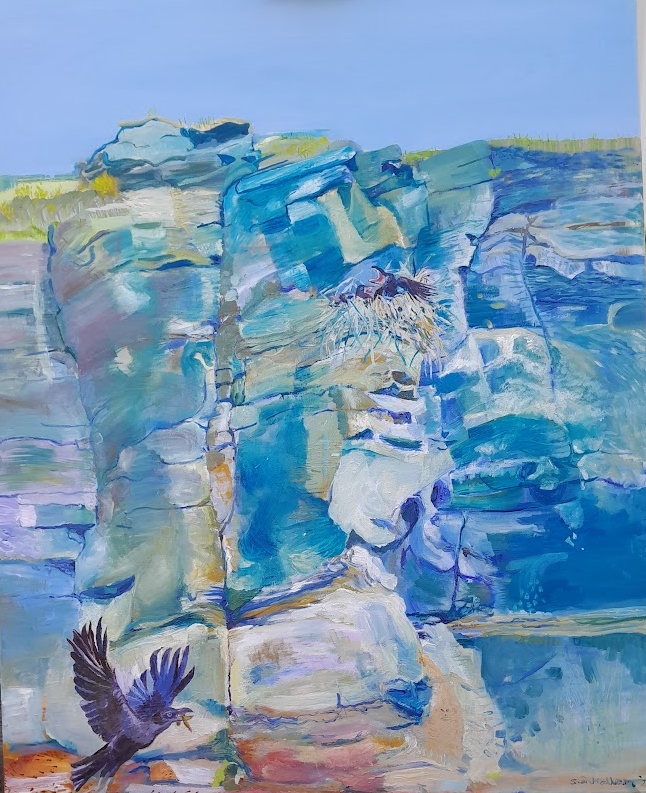
Sian Hallam
SNAIL SHELLS
I gained my inspiration for this painting by visiting some disused quarry sites round the Wirksworth / Bonsall area. It was quite cold and I found a lot of snail shells, so I painted them when I returned home. The light was bright and I liked the strong contrasting shadows that they cast in the spring sunshine. I arranged them to reflect their own spiral shapes which seem to represent the on going nature of life and death. They were all vacant when I picked them up, left by their previous occupants to biodegrade perfectly in to the environment; a perfect lesson in sustainability. The shape reminds me of the myriad of possibilities for change that a fractal can offer, and the Theory of Chaos. The sheer number of snail shells that I encountered represent the many life forms that thrive on the high quality base limestone deposits that are quarried and exposed, as they are made from this calcium carbonate, and provide a source of this mineral for members of the food chain. Longcliffe returns their quarry sites to nature by keeping them as nature reserves, for wildlife to recolonise. The snail shells represent all this and more!
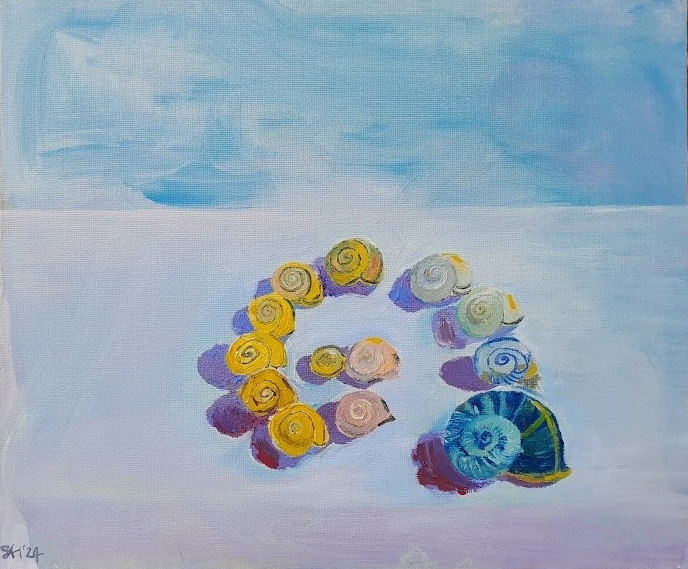
Squiggly Sue
ATTENBOROUGH
This image is called ‘Attenborough’ and is of a painting I created inspired by Attenborough Nature Reserve, somewhere very close to our hearts. Attenborough Nature Reserve was established in 1966 and opened by Sir David Attenborough. It is widely recognised as a nationally important site for birds, wildlife and plants. They have a strong ethos of conservation and sustainability and work hard to promote people’s connection to nature in a way that can highlight the importance of and maintenance of the natural world, to tackle the ecological crisis and be a catalyst to tackle global issues through local action.

Susan Dodd
THE LIZARDS GO HUNTING
Made from paper, chocolate wrappers and used lager cans. This work shows the harmony of nature, the moths lay their eggs and pollinate the passion flowers and the lizards eat the moths, and hopefully the cycle continues.

Tru Udell
I was running/walking Sunday 9th June up Hopton Via Gellia (The Dene) and saw a farmer ploughing his field. I noticed the hedge rows full of life in the foreground and the wind turbines in the background. The separation was by a stone wall and the hills and trees. The birds were following the freshly ploughed soil. In that moment I decided this was prefect for my inspiration for the sustainability competition.
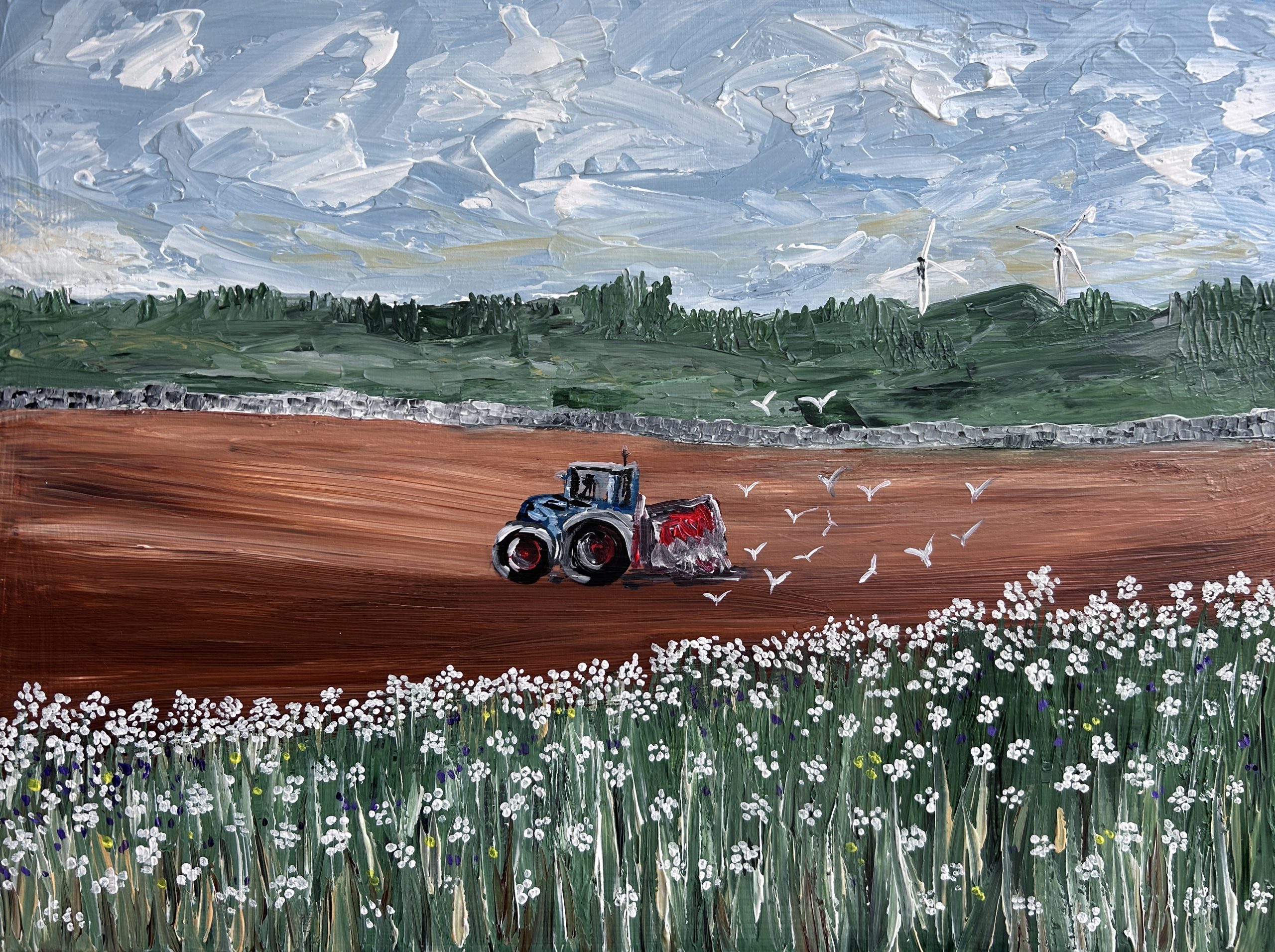
Valerie Dalling
WILD AT HEART
Location – Brightgate, Bonsall Lane.
Digital Art
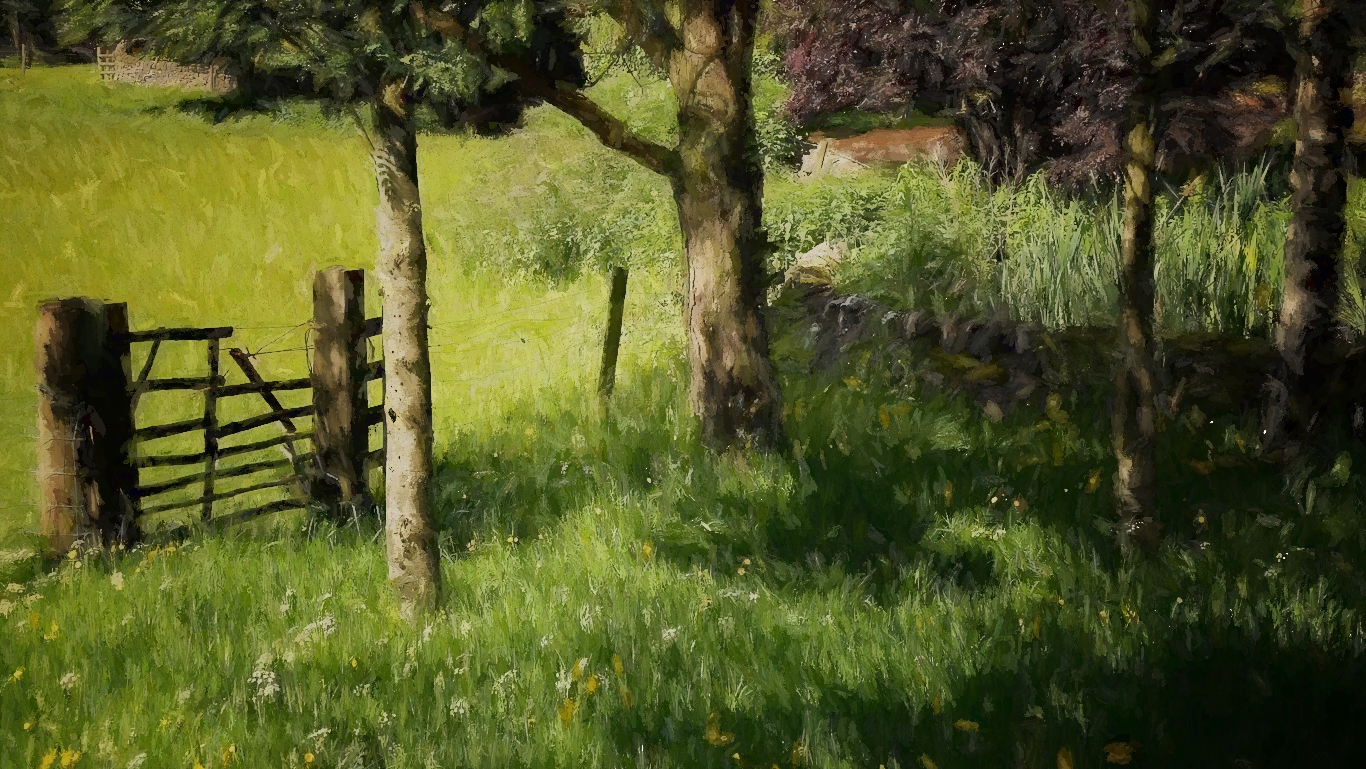
Zaza Lewis
WILDFLOWERS
I wanted to highlight the importance of the wildflowers by giving them a disproportionate space in this picture, almost an ant-like view of the surrounding.
It was created it after walking up on hills in Derbyshire, close to Derby, and close to a few major thoroughfares and built-up areas. However, you can only access these fields by walking, and there were plenty of insects thriving.
The majority of the fabrics used in this picture are recycled and rescued fabrics, and the card bought from sustainable paper sources.
